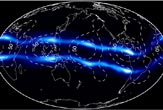
Space weather in the upper reaches of the atmosphere is affected by weather conditions down here on Earth, a new study suggests.
Using a combination of satellite imagery and computer simulations, researchers found that tides of air created by intense thunderstorms over South America, Africa and Southeast Asia are altering the structure of the ionosphere, the topmost layers of the atmosphere where space weather occurs.
The finding, detailed in the Aug. 11 issue of Geophysical Research Letters, is surprising because scientists didn't think the ionosphere and the troposphere--the lower part of the atmosphere where terrestrial weather happens--affected one another.
"This discovery will help improve forecasts of turbulence in the ionosphere, which can disrupt radio transmissions and the reception of signals from the Global Positioning Satellite," said study leader Thomas Immel of the University of California, Berkeley.
Earth's electric blanket
The ionosphere is a layer off electrically charged gas, called "plasma," that blankets the Earth. It's formed when X-rays and ultraviolet rays from the Sun collide with and break apart atoms and molecules in the upper atmosphere. The densest part of the ionosphere forms two bands of plasma close to the equator about 250 miles above the surface of the Earth.
From March 20 to April 20, 2002, sensors aboard NASA's Imager for Magnetosphere to Aurora Global Exploration (IMAGE) satellite recorded these bands, which glow in ultraviolet light.
Get the world’s most fascinating discoveries delivered straight to your inbox.
The images revealed four pairs of bright spots in the bands where the plasma was thicker than average. One of the pairs was located above the Pacific Ocean, but three of them were situated above the Amazon Basin in South America, the Congo Basin in Africa and Indonesia--areas with lots of thunderstorm activities.
Using Global Scale Wave Model, a computer simulation developed by the National Center for Atmospheric Research (NCAR), the researchers confirmed that the areas above the tropical rainforests produce tides of air in the atmosphere. These tides indirectly affect the plasma bands by modifying a layer of the atmosphere that helps shape them.
The E-layer
Scientists think it works like this: Below the plasma bands, a layer of the ionosphere called the E-layer becomes partially electrified during the day. High-altitude winds blow electrically-charged plasma in the E-layer across the Earth's magnetic field, creating an electric field.
This electric field shapes the plasma above the E-layer into two bands. Therefore, anything that changes the motion of the E-layer plasma also affects the electric fields it generates; this in turn reshapes the plasma bands.
The computer simulation indicates that the tides of air generated by thunderstorms dumps their energy into the E-layer, which is located about 70 miles above the Earth. This disrupts the plasma currents there, altering the E-layer's electric field and creating dense, bright zones in the plasma bands above.
The single pair of intense plasma zones over the Pacific Ocean is not associated with thunderstorm activity, Immel said, but could be a sign that the ionosphere disturbances somehow propagate around the Earth.
The discovery has immediate implications for space weather forecasts because it identifies four sectors of the planet where space storms can produce higher than normal disturbances in the ionosphere.
"We now know that accurate predictions of ionospheric disturbances have to incorporate this effect from tropical weather," Immel said.


